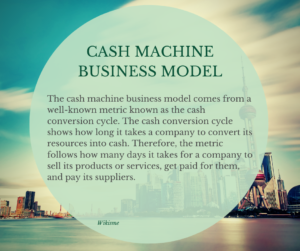The cash machine business model comes from a well-known metric known as the cash conversion cycle. The cash conversion cycle shows how long it takes a company to convert its resources into cash.
Therefore, the metric follows how many days it takes for a company to sell its products or services, get paid for them, and pay its suppliers.
Companies using a cash machine business model usually have a short cash conversion cycle. These companies either offer cash sales or have significantly low credit terms, allowing them to receive cash from customers promptly.
Similarly, some of these companies use their cash resources to pay suppliers readily to avoid lengthening their cash conversion cycle.
Similarly, companies using a cash machine business model have low-profit margins to generate high volume sales. However, for some of them, the necessity to keep low margins may come due to the disruptive industry in which they operate. The cash machine business model is most suitable for companies that keep inventory.

How Does the Cash Machine Business Model Work?
The cash machine business model is straightforward. A company buys its raw materials from a supplier. It may either pay the supplier at the time of the transaction with cash or use its credit facilities.
Then the company works towards processing its raw materials and converting them into finished goods. After that, the company waits for customer orders.
Once the company receives an order, it ships the goods to its customers. Usually, cash machine companies don’t offer credit transactions and receive their cash promptly.
It allows them to substantially reduce their cash conversion cycle by not having to wait until customers pay. However, some companies may also offer credit terms to customers to attract more sales.
However, the credit terms that companies offer for their sales in this model are usually short-term. For example, these companies may offer a 5-10 days credit term.
Likewise, it is one of the reasons why a company can keep its cash conversion cycle low. Lastly, when the customer repays the company for the goods purchased, the company reimburses its suppliers.
The primary factors that influence the success of a company that uses this mode are receiving cash from customers promptly and repaying suppliers.
It allows companies to collect a cash surplus, which further helps them repay suppliers before obtaining further payments from customers, which shortens their cash conversion cycle even more.
What are the advantages and disadvantages of the Cash Machine business model?
The cash machine business model has several advantages and disadvantages. Some of these consist of the following.
Advantages
Using a cash machine business model allows companies to smooth out their operations and processes. By receiving cash from customers promptly and repaying suppliers, companies can avoid any latency in their cash flows. It further allows them to predict or forecast their cash flows for budgeting and control purposes.
The business model also allows companies to minimize their credit risk. Credit risk is the risk associated with the repayment of loans by borrowers.
If a borrower fails to repay a company, it results in bad debts. Therefore, companies using this model usually face the lowest and, sometimes, no bad debts, at all.
A cash machine business model also allows companies to make use of any incentives offered by suppliers. If a company keeps a low cash conversion cycle, it means it repays its suppliers on time.
Therefore, if a supplier provides a cash discount for early repayments, companies can exploit their business model to reimburse them less.
Companies using this model can also generate excess cash flows and avoid cash shortages. By exploiting those situations, companies can reinvest their cash in new projects and earn more from them. Therefore, the cash machine business model allows them to generate higher cash inflows and expand their businesses.
Disadvantages
While the cash machine business model is about shortening a company’s cash conversion cycle, it may not always be a good thing. For example, by repaying suppliers promptly, companies don’t benefit from waiting out through the credit term period and utilizing the cash elsewhere.
Similarly, by not offering customers shorter credit terms or none at all, companies may lose customers. As mentioned, companies can avoid credit risk with it. However, taking the risk can result in higher rewards and more sales as well.
Examples
Some well-known companies that utilize the cash machine business model are Amazon and Apple. They offer no credit terms to customers, which allows them to collect any cash promptly from customers.
Similarly, they use the money to repay their suppliers on time, allowing them to have a significantly lower cash conversion cycle.
Conclusion
The cash machine business model is for companies that believe in a short cash conversion cycle. The business model works by decreasing or eliminating the time it takes companies to collect receipts from customers. Similarly, it allows them to repay their suppliers on time.